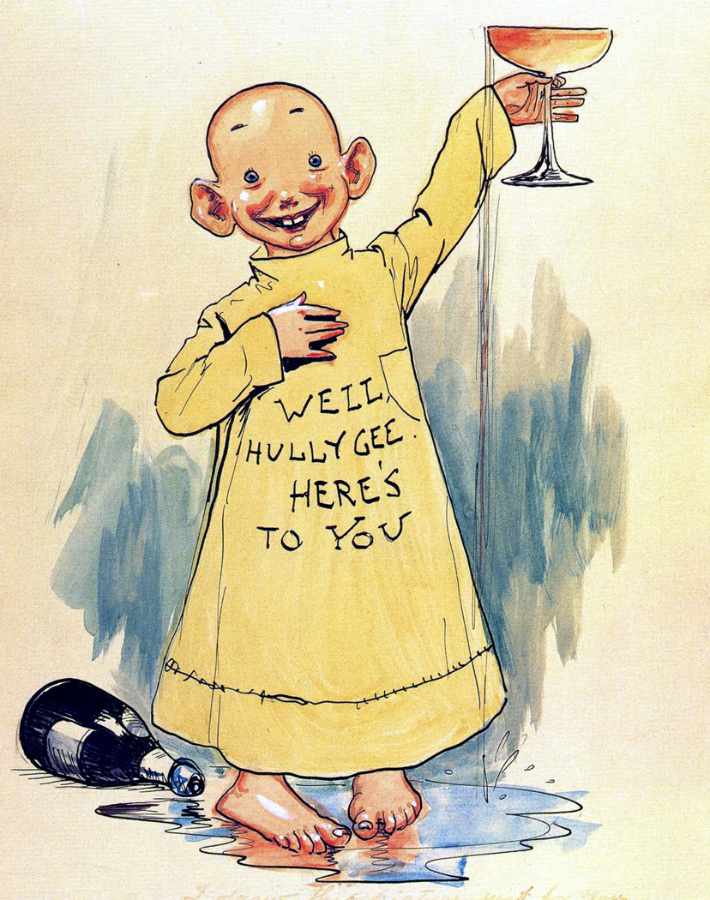The Yellow Kid was a bald, snaggle-toothed barefoot boy who wore an oversized yellow nightshirt and hung around in a slum alley typical of certain areas of squalor that existed in late 19th-century New York City. Hogan’s Alley was filled with equally odd characters, mostly other children. With a goofy grin, the Kid habitually spoke in a ragged, peculiar slang, which was printed on his shirt, a device meant to lampoon advertising billboards. The Yellow Kid’s head was drawn wholly shaved as if having been recently ridden of lice, a common sight among children in New York’s tenement ghettos at the time. His nightshirt, a hand-me-down from an older sister, was white or pale blue in the first color strips. In 1902, Richard F. Outcault said “The Yellow Kid was not an individual but a type. When I used to go about the slums on newspaper assignments I would encounter him often, wandering out of doorways or sitting down on dirty doorsteps. I always loved the Kid. He had a sweet character and a sunny disposition, and was generous to a fault. Malice, envy or selfishness were not traits of his, and he never lost his temper.” The cartoon was created to help educate the wealthy readers of the newspapers in which the comic strip appeared, showing them something of what life was like for people living in poverty. Outcault’s aim was to make these wealthy readers more sympathetic to the plight of the poor, rather than judging them, and assuming they deserved to be in poverty. The Yellow Kid is also famous for its connection to the coining of the term “yellow journalism”, which referred to stories which were sensationalized for the sake of selling papers, and was so named after the “Yellow Kid” cartoons. Although a cartoon, Outcault’s work aimed its humor and social commentary at New York World’s adult readership. The strip has been described as “a turn-of-the-century theater of the city, in which class and racial tensions of the new urban, consumerist environment were acted out by a mischievous group of New York City kids from the wrong side of the tracks”.
| Alias Yellow Kid |
| Real Names/Alt Names Mickey Dugan |
| Characteristics Newspaper Strip Characters, Realism and Victorian Age, Juvenile |
| Creators/Key Contributors Richard F. Outcault |
| First Appearance “Fourth Ward Brownies” in Truth magazine (9 February 1895) |
| First Publisher Truth Magazine/New York World |
| Appearance List “Fourth Ward Brownies” in Truth magazine (9 February 1895), “Hogan’s Alley” in the New York World (March 1895-1898), “McFadden’s Row of Flats” in New York Journal American (18 October 1896-10 January 1897), “Around the World with the Yellow Kid” in New York Journal American (17 January-30 May 1897), “Ryan’s Arcade” in New York Journal American (28 September 1897-23 January 1898) |
| Sample Read The Yellow Kid [CB+] |
| Description The Yellow Kid was a bald, snaggle-toothed barefoot boy who wore an oversized yellow nightshirt and hung around in a slum alley typical of certain areas of squalor that existed in late 19th-century New York City. Hogan’s Alley was filled with equally odd characters, mostly other children. With a goofy grin, the Kid habitually spoke in a ragged, peculiar slang, which was printed on his shirt, a device meant to lampoon advertising billboards. The Yellow Kid’s head was drawn wholly shaved as if having been recently ridden of lice, a common sight among children in New York’s tenement ghettos at the time. His nightshirt, a hand-me-down from an older sister, was white or pale blue in the first color strips. In 1902, Richard F. Outcault said “The Yellow Kid was not an individual but a type. When I used to go about the slums on newspaper assignments I would encounter him often, wandering out of doorways or sitting down on dirty doorsteps. I always loved the Kid. He had a sweet character and a sunny disposition, and was generous to a fault. Malice, envy or selfishness were not traits of his, and he never lost his temper.” The cartoon was created to help educate the wealthy readers of the newspapers in which the comic strip appeared, showing them something of what life was like for people living in poverty. Outcault’s aim was to make these wealthy readers more sympathetic to the plight of the poor, rather than judging them, and assuming they deserved to be in poverty. The Yellow Kid is also famous for its connection to the coining of the term “yellow journalism”, which referred to stories which were sensationalized for the sake of selling papers, and was so named after the “Yellow Kid” cartoons. Although a cartoon, Outcault’s work aimed its humor and social commentary at New York World’s adult readership. The strip has been described as “a turn-of-the-century theater of the city, in which class and racial tensions of the new urban, consumerist environment were acted out by a mischievous group of New York City kids from the wrong side of the tracks”. |
| Source The Yellow Kid – Wikipedia |

